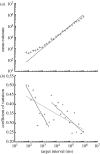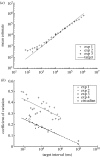The precision of temporal judgement: milliseconds, many minutes, and beyond
- PMID: 19487192
- PMCID: PMC2685820
- DOI: 10.1098/rstb.2009.0020
The precision of temporal judgement: milliseconds, many minutes, and beyond
Abstract
The principle that the standard deviation of estimates scales with the mean estimate, commonly known as the scalar property, is one of the most broadly accepted fundamentals of interval timing. This property is measured using the coefficient of variation (CV) calculated as the ratio between the standard deviation and the mean. In 1997, John Gibbon suggested that different time measurement mechanisms may have different levels of absolute precision, and would therefore be associated with different CVs. Here, we test this proposal by examining the CVs produced by human subjects timing a broad range of intervals (68 ms to 16.7 min). Our data reveal no evidence for multiple mechanisms, but instead show a continuous logarithmic decrease in CV as timed intervals increase. This finding joins other recent reports in demonstrating a systematic violation of the scalar property in timing data. Interestingly, the estimated CV of circadian judgements fits onto the regression of decreasing CV, suggesting a link between short interval and circadian timing mechanisms.
Figures




Similar articles
-
Circadian food anticipatory activity: Entrainment limits and scalar properties re-examined.Behav Neurosci. 2014 Dec;128(6):689-702. doi: 10.1037/bne0000017. Epub 2014 Oct 6. Behav Neurosci. 2014. PMID: 25285457
-
Violation of the scalar property for time perception between 1 and 2 seconds: evidence from interval discrimination, reproduction, and categorization.J Exp Psychol Hum Percept Perform. 2012 Aug;38(4):880-90. doi: 10.1037/a0027188. Epub 2012 Mar 5. J Exp Psychol Hum Percept Perform. 2012. PMID: 22390291
-
The Strength of Alpha-Beta Oscillatory Coupling Predicts Motor Timing Precision.J Neurosci. 2019 Apr 24;39(17):3277-3291. doi: 10.1523/JNEUROSCI.2473-18.2018. Epub 2019 Feb 21. J Neurosci. 2019. PMID: 30792271 Free PMC article.
-
Scalar properties in animal timing: conformity and violations.Q J Exp Psychol (Hove). 2006 Nov;59(11):1875-908. doi: 10.1080/17470210600784649. Q J Exp Psychol (Hove). 2006. PMID: 16987779 Review.
-
Timing using temporal context.Brain Res. 2010 Dec 13;1365:3-17. doi: 10.1016/j.brainres.2010.07.045. Epub 2010 Jul 21. Brain Res. 2010. PMID: 20654587 Free PMC article. Review.
Cited by
-
Cognitive load, fatigue and aversive simulator symptoms but not manipulated zeitgebers affect duration perception in virtual reality.Sci Rep. 2022 Sep 20;12(1):15689. doi: 10.1038/s41598-022-18520-1. Sci Rep. 2022. PMID: 36127357 Free PMC article.
-
Learning of temporal motor patterns: an analysis of continuous versus reset timing.Front Integr Neurosci. 2011 Oct 13;5:61. doi: 10.3389/fnint.2011.00061. eCollection 2011. Front Integr Neurosci. 2011. PMID: 22016724 Free PMC article.
-
Hyperbolic discounting emerges from the scalar property of interval timing.Front Integr Neurosci. 2011 Jun 6;5:24. doi: 10.3389/fnint.2011.00024. eCollection 2011. Front Integr Neurosci. 2011. PMID: 21713111 Free PMC article. No abstract available.
-
Internal representations of temporal statistics and feedback calibrate motor-sensory interval timing.PLoS Comput Biol. 2012;8(11):e1002771. doi: 10.1371/journal.pcbi.1002771. Epub 2012 Nov 29. PLoS Comput Biol. 2012. PMID: 23209386 Free PMC article.
-
A purely visual adaptation to motion can differentiate between perceptual timing and interval timing.Proc Biol Sci. 2023 Jun 14;290(2000):20230415. doi: 10.1098/rspb.2023.0415. Epub 2023 Jun 7. Proc Biol Sci. 2023. PMID: 37282539 Free PMC article.
References
-
- Aschoff A., Kremer P. Determining the best cerebrospinal fluid shunt valve design: the pediatric valve design trial. Neurosurgery. 1998;42:949–951. doi:10.1097/00006123-199804000-00160 - DOI - PubMed
-
- Bizo L.A., Chu J.Y., Sanabria F., Killeen P.R. The failure of Weber's law in time perception and production. Behav. Process. 2006;71:201–210. doi:10.1016/j.beproc.2005.11.006 - DOI - PubMed
-
- Breukelaar J.W., Dalrymple-Alford J.C. Effects of lesions to the cerebellar vermis and hemispheres on timing and counting in rats. Behav. Neurosci. 1999;113:78–90. doi:10.1037/0735-7044.113.1.78 - DOI - PubMed
-
- Brunner D., Fairhurst S., Stolovitzky G., Gibbon J. Mnemonics for variability: remembering food delay. J. Exp. Psychol. Anim. Behav. Process. 1997;23:68–83. doi:10.1037/0097-7403.23.1.68 - DOI - PubMed
-
- Buhusi C.V., Meck W.H. What makes us tick? Functional and neural mechanisms of interval timing. Nat. Rev. Neurosci. 2005;6:755–765. doi:10.1038/nrn1764 - DOI - PubMed
MeSH terms
Grants and funding
LinkOut - more resources
Full Text Sources

